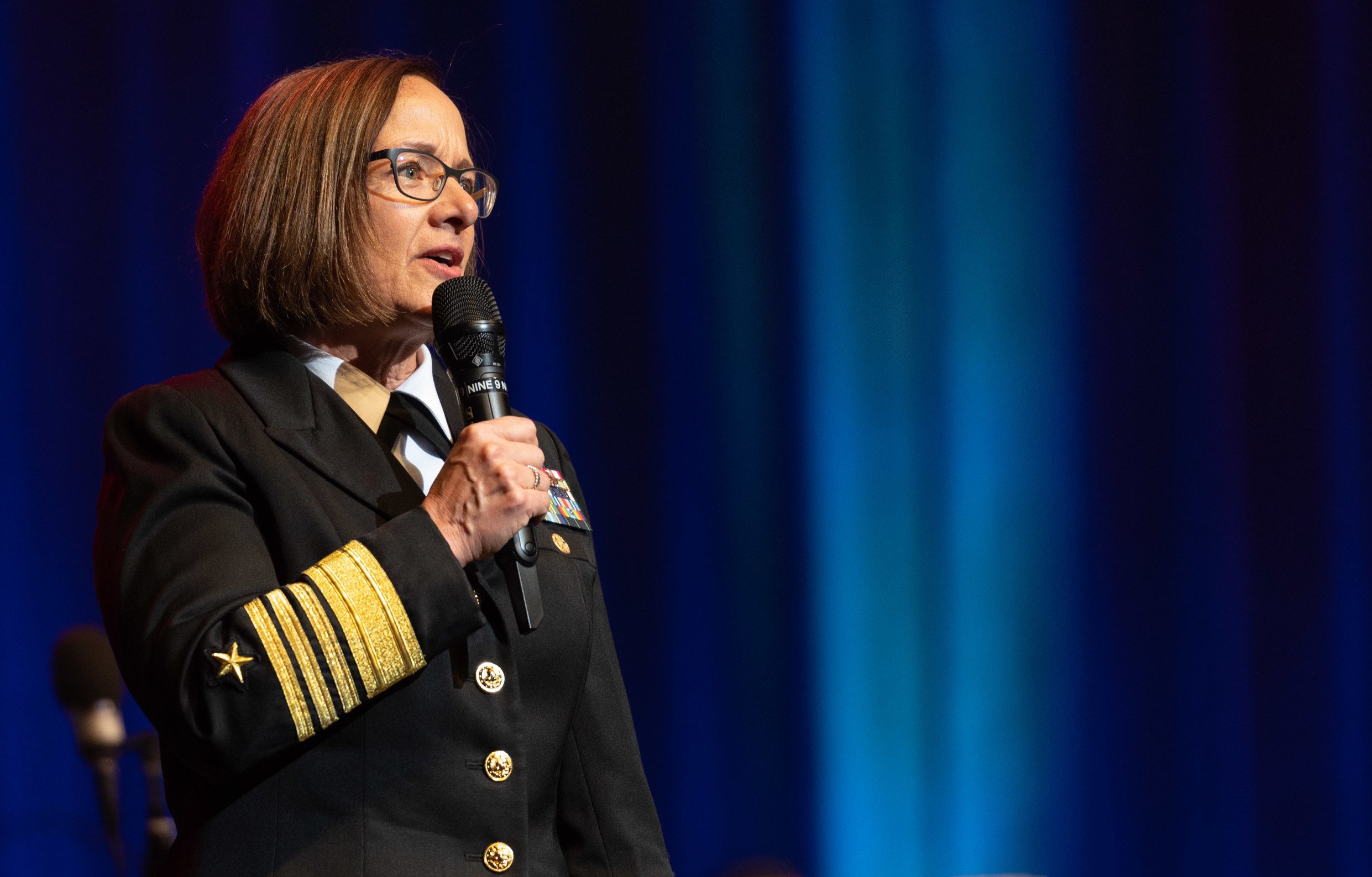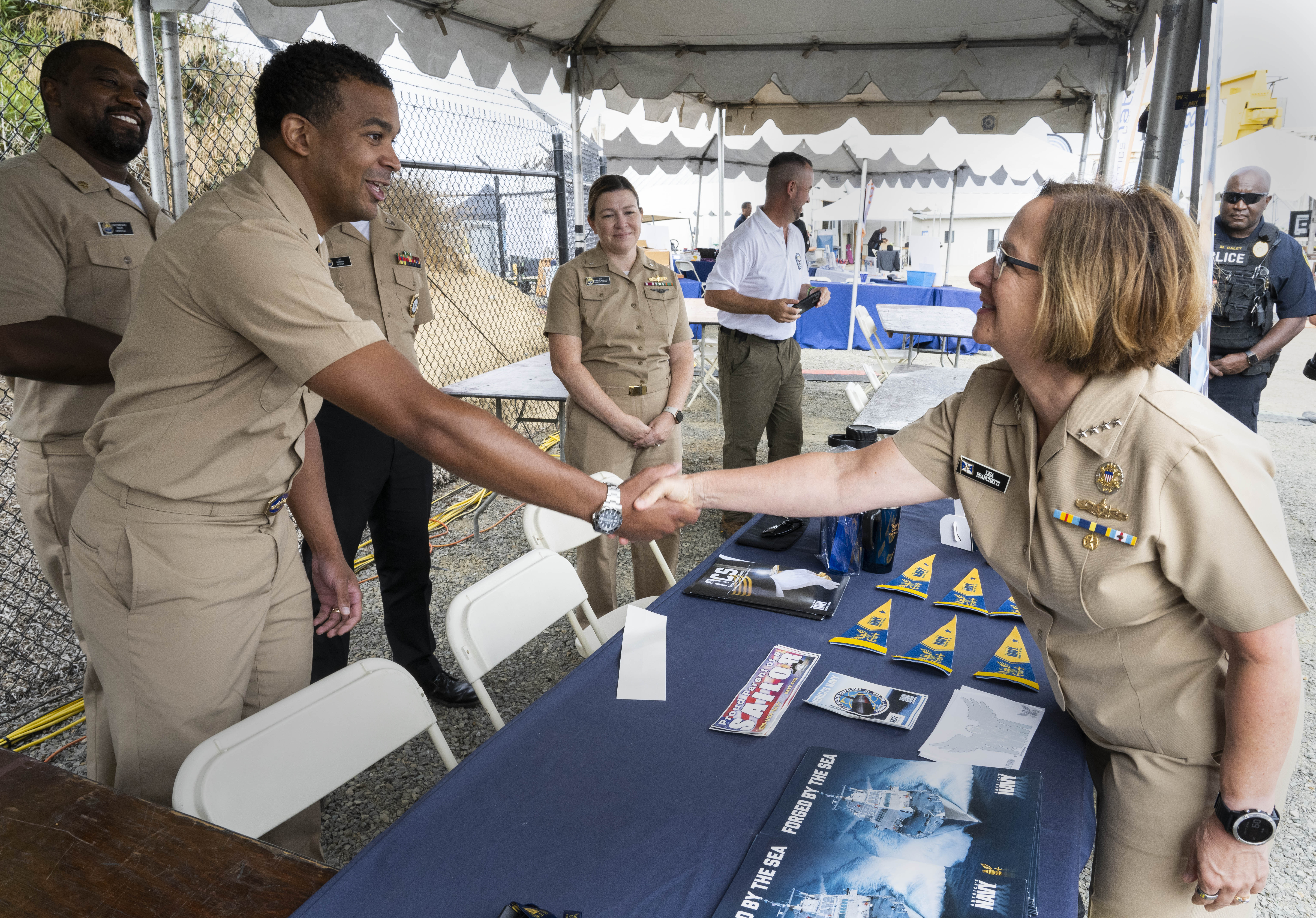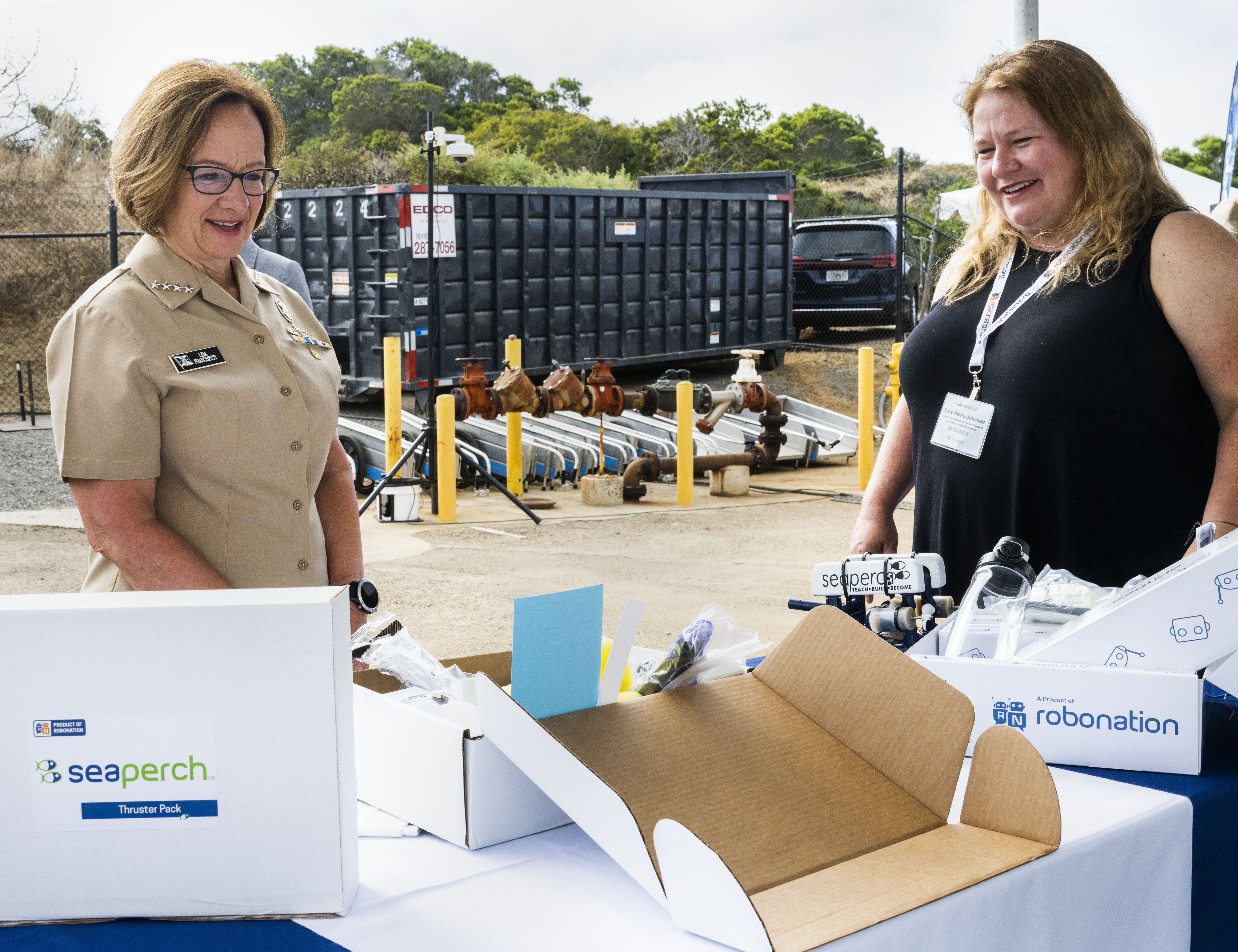
NAVAL BASE POINT LOMA, Calif. – As teams of college and high school students pored over their home-built robotic submarines and others prepared to place theirs in a huge, hillside water tank, Adm. Lisa Franchetti couldn’t be happier with what she saw.
Franchetti, current vice chief of naval operations and self-described STEM fan, sees the Navy’s strength and future in the science, technology, engineering and mathematics skills displayed by students and their autonomous underwater vehicles built for this year’s RoboSub competition.
“It’s really neat to see that, the teamwork, the leadership when you talk about building a team, overcoming challenges, being resourceful, resilient. Those are all things that we want people that work with our Navy team to be able to do,” Franchetti told USNI News in her first interview since she was nominated to succeed Adm. Mike Gilday as the chief of naval operations.
RoboSub and other similar STEM events aimed at young people – and perhaps future prospective recruits or civilian workers – are important for the Navy’s outreach efforts and “bring a lot more exposure to what we do and get that interaction going,” she said. “It’s really important to recruiting, so they can see [a Navy career] as one of their options.”
This year marks the 26th iteration of the International Student Robotic Submarine competition that’s co-hosted by the Office of Naval Research and Naval Information Warfare Center Pacific, or NIWC-Pacific, and held at the Transducer Evaluation Center, a six million-gallon pool known as TRANSDEC at Naval Base Point Loma. Thirty-four teams – including international teams from Bangladesh, Canada, India and Singapore – are participating in the competition, which began July 31 and ends Aug. 6.
An event like RoboSub, Franchetti said, can spur excitement for anything STEM among high school and college students. With the Navy’s growing focus on unmanned technologies, Franchetti said the competition encourages “the type of thinking and leadership that we need for our nation and also for our Navy.”
While a friendly competition, the RoboSub event is built around tackling and solving issues that are relevant to the contemporary maritime environment.
“They’ve set up some challenges that an autonomous underwater vehicle would have to do, and so they are challenging the students to solve real-world problems that real-world scientists are working on,” she said.
With the establishment of Unmanned Task Force 59 and issuance of the Unmanned Campaign Plan, Franchetti noted, “Admiral Gilday has really charged us with getting after unmanned [capabilities].”
“A lot of progress has been made in that area,” she said. “As we look to the future, we know that we’re going to have always our conventional platforms. But we’re going to have unmanned, and getting them to work together and getting our sailors to work together with unmanned platforms is something that this kind of environment right here … does a great job of fostering that connection and that sort of different thinking about how we can leverage unmanned to do all the things we need to do as a Navy.”
“Technology is always changing,” she said, noting that Gilday “has said that the nation that can embrace and adapt to using new technology effectively is going to be the nation to prevail in crisis and win in wars. We’ve got to be able to think about what that new technology is and how we are going to stay one step ahead of it and make sure we can always use it.”
“We are a very technically oriented service,” Franchetti said, “and we need engineering, we need critical thinking, we need problem-solvers, and they’re getting all of that through the RoboSub competition … whether it is in engineering, propulsion, a weapon system, a combat system.”
A Meeting of the Minds

Franchetti spent some time Wednesday morning talking with some of the teams. “I asked them what your most challenging thing was, and it was about integrating all of the different software that have to talk with each other,” she said. “These are real-world problems that real-world engineers and scientists deal with every day, and they’re getting to practice that here and learn, not only from each other but from our best scientists and technical engineers that are here.”
RoboSub began 26 years ago, when Daryl Davidson met a then-ONR program manager, Tom Curtis, on a flight to Washington, DC. It was serendipitous. They both wanted to run competitions for students, Davidson recalled. With funding in hand a year later, they organized the first event, held in 1998 in Panama City, Fla. The competition shifted to the TRANSDEC pool at Point Loma in 2002. COVID interrupted the program, but it resumed in Maryland last year.
“We want to get them interested as early as possible and light that fire of what robotics is all about and what autonomy is all about, and then move them all the way up the pipeline and they become the workforce of tomorrow,” said Davidson, president and chief executive officer of RoboNation, an independent, nonprofit educational organization. “Many of the kids that have gone through this have started companies. They’re working for NIWC. They’re working for the Navy in other commands.”
“It’s all about learning. It’s about collaboration with the teams,” he said. “If one team is struggling, there’s very likely another team that’s going to help them out. … It’s about building a robotics community more than just a focus on winning.”
Underwater Challenges

The TRANSDEC pool, which ranges from 16 feet to 38 feet deep, is an “infinite acoustic expanse” research pool, akin to an underwater soundproof room that simulates the vast ocean depths. “The idea here is to be able to isolate, to just focus on measuring what you want to measure,” said Travis Moscicki, the NIWC-Pacific lead for RoboSub.
At RoboSub, it’s not all about how each team’s AUV performs, officials say. “The output of these competitions is not the vehicles, it’s the people who build those vehicles,” Moscicki said. “At the end of the day, the problem is always going to change. We’re going to need a new widget. We’re going to need to build a better mousetrap. What we need is folks who can do that for us.”
Each team designs and builds an autonomous, unmanned underwater vehicle. Some teams fundraise to cover the costs to build their AUVs while others have deep-pocketed sponsors. It’s not just about the vehicle. Teams have to write a paper, go before a panel and develop a website, Davidson said.
Each team has a 30-minute slot to run their AUV through several tasks for this year’s RoboSub challenge: The AUV must drive through a submerged gate – this year’s competition has “Stargate SG-1” TV show themes – and, depending on which side it crosses, tackle tasks such as shooting a projectile through an opening or picking up chevrons the size of a coffee cup lid to drop into a bin.
The tasks can be more challenging than those in other robotics competitions. “The difference is, this is autonomous. There is no control, there is no human operator,” Moscicki said, adding “you have to have some very tight algorithms and fine-tuned controls.”
As far as he knows, no team has worked up to the finals and completed all of the challenges. “We want to keep it that way,” he said, “because we want 100 percent of what they can do. … We want to push them to that next level and say, ‘Hey, how are we going [to] problem-solve this thing that we’ve never seen before?’”
Moscicki knows first-hand, having experienced the series of RoboNation events – 5 RoboBoat and three RoboX competitions – as a student on a team starting in 2014. He holds a doctorate in ocean engineering and now has a science and technology job at NIWC-Pacific. He has several interns supporting the event, “and they’re getting the experience of critical thinking, of problem-solving, of creative solutions,” he said, adding “it’s just getting them excited about what this work looks like.”
The competition is intense, and days and nights can get long as teams sort through hiccups and problems, such as faulty propulsion or troublesome switches.
“The software and navigation is quite difficult underwater because you don’t have GPS,” said Mabel Szeto, a member of Team Inspiration, a University of California San Diego student and a technical intern this summer with Northrop Grumman in San Diego. “We try to collaborate as much as we can.”





